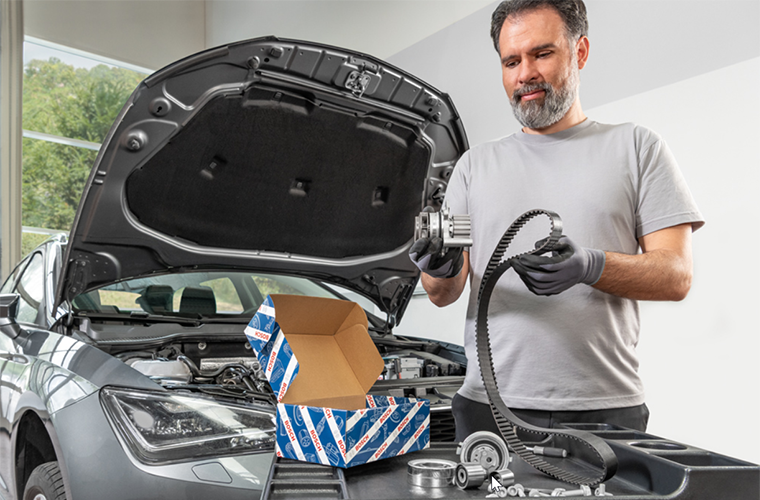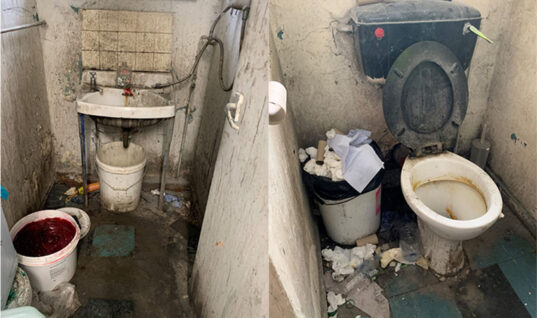Replacement of a timing belt or the complete kits isn’t an easy task. Here, Bosch provides complementary installation instructions (in addition to the ESI[tronic] installation manual) for replacing a timing belt or the complete kit.
Please note the instructions below in addition to the ESI[tronic] installation manual when replacing the timing belt or the complete kit.
Applies to all water-pump kits
Rinsing the cooling system
Notes on the replacement of water pumps
Coolant should be changed every third year or according to the vehicle manufacturer specifications.
Before replacing the water pump, drain the coolant and check it for possible impurities. In case there are any, the cooling circuit is to be cleaned with the old water pump still installed. In case the system is not cleaned, a defective slide-ring seal or bearing failure could cause the new water pump to fail soon after putting it into operation.
Possible impurities
- Aluminium particles caused by internal corrosion of the radiator.
- Foreign matters, additives or sealant.
- Particles resulting from maintenance or a defective coolant pump.
Explanation of particles:
- Whitish emulsion e.g. on the oil cap caused by contamination of coolant with oil. In this case, before checking the cooling system, a CO2 leakage tester is to be used to check if there are any combustion gases leaking into the cooling circuit through cracks at the cylinder head or a defective cylinder head gasket.
- Calcareous deposits because of use of chalky water.
- Brown coolant coloration due to inner corrosion or in case corrosion-protection agents within the coolant have been exhausted.
Cleaning agent
In case of calcareous deposits, a 5 percent lemon acid solution is to be used. In case of oil residues, use a mild alkaline 5 percent solution of distilled water.
General note
Drain via drain screw and fill via expansion tank or radiator. The system usually bleeds itself or by means of bleed valves.
Attention
Observe the vehicle manufacturer specifications for the respective vehicle under any circumstances.
Procedure
- Fully drain the engine releasing all coolant contained and fill the cooling circuit with cleaning agent.
- Start the engine, turn on the heating and leave the engine turned on for approximately 10 minutes once the thermostat opened.
- Once the engine has cooled down, release the cleaning agent and make sure, all deposits dissolved. If not, flush again.
- After cleaning the cooling circuit, flush twice using fresh water. After each flushing process, run the engine for 5 to 10 minutes. In case there is an electric continued coolant circulation turned on, wait until it turns off.
- Once the engine cooled down, remove the water pump.
Attention
The cleaning agent and the coolant released are to be disposed of properly. As they contain glycol, they are toxic.
- Install the new water pump according to the manufacturer specifications.
Attention
Do not turn the new water pump while dry. Otherwise, the slide-ring seal could be damaged.
- In case the new water pump needs to be installed using sealing glue or a sealing compound, make sure to apply the sealing agent both sparingly and evenly. Sealing agents are subject to varying drying speeds. Please observe the manufacturers processing information. In case the new water pump comes with a seal or an O-ring, no sealing compound must be used.
- Fill the engine with the specified amount of coolant and run it until it warms up.
- Once the engine cooled down, check the coolant level.
- Mechanical shaft sealing of the water pump.
- Replacement or maintenance are not possible.
- Do not actuate the water pump during the fitting without water or coolant available in the system.
As a matter of principle, water pumps are equipped with a sealing system varying from the one used for shaft outputs in combustion engines, (e.g. rotary seal ring or shaft packaging). The standard today is a sealing system with slide rings.
Depending on the requirements, these are made from graphite, aluminium oxide, tungsten carbide or silicon carbide (ceramics). In order to ensure optimum sealing even with depressurised cooling systems, the slide rings are pushed onto each other by means of spring force.
Throughout the first hours after installing a new water pump, minor coolant leakages are absolutely normal until the slide rings have worn in. Consequently, minor coolant leakages on the drain hole are no reason for complaints.
Important
Do not actuate or turn a dry water pump during the fitting. The slide rings are not yet lubricated by the coolant.
For historical or vintage vehicles, there might be water pumps used with ‘conventional’ shaft seal. These may even require maintenance or service from time to time. However, such classic products are not part of the Drive Technology portfolio.







